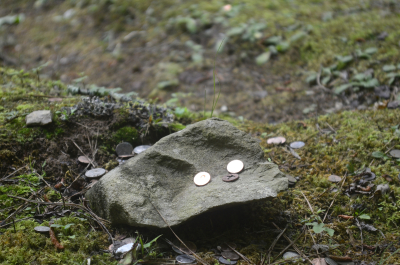Mysteries of Enloe Cemetery: Hidden Histories in the Smoky Mountains
In a shaded clearing near Mingus Mill lies a cemetery. Small, unmarked rocks sit at the head and foot of each plot, adorned with shimmering coins visitors have left as tokens of respect. The names, life stories, and even the exact number of people occupying Enloe Cemetery in Great Smoky Mountains National Park have long been shrouded in mystery, waiting for curious souls to discover their stories.
Having hiked these misty mountain trails for over a decade, I’ve always been drawn to the hidden histories tucked away in these ancient hills. There’s something hauntingly beautiful about Enloe Cemetery that captures the essence of the Smokies – both revealed and concealed, much like the fog that rolls through these valleys at dawn.
The Forgotten Stories of Enloe Cemetery
Walking among these simple stone markers, I’m always struck by how nature has nearly reclaimed this sacred ground. Unlike the manicured cemeteries we’re accustomed to seeing, Enloe Cemetery represents mountain burial traditions in their purest form – unpretentious, connected to the land, and eerily timeless.
The cemetery dates back to the early 1800s when European settlers first established permanent communities in these mountains. These were hardscrabble farmers, hunters, and craftspeople who carved out lives in one of America’s most challenging landscapes. Their grave markers tell no tales – just silent stones pointing skyward, with occasional coins left by modern visitors honoring lives long past.
Who Were the Enloes?
The Enloe family was among the early pioneer families who settled in what would eventually become part of Great Smoky Mountains National Park. Historical records suggest they were farmers who worked the fertile bottomlands near Oconaluftee River, raising crops and livestock much like their Cherokee neighbors had done for generations before.
Abraham Enloe, perhaps the most documented family member, lived near what is now Cherokee, North Carolina in the early 1800s. Local folklore even connects him to some fascinating historical tales, though separating fact from mountain legend remains challenging for historians.
The Tradition of Leaving Coins
If you visit Enloe Cemetery today, you’ll notice something peculiar – coins balanced atop many of the grave markers. This isn’t random; it’s part of a fascinating tradition that’s evolved over decades.
I remember asking a park ranger about this practice years ago. “It started as a way for visitors to show respect,” she told me. “In mountain culture, leaving something of value was a way to honor the dead. Coins were something simple people could spare.”
The practice has deeper symbolic meaning too. In various cultures, coins help the deceased pay their way in the afterlife. Whether visitors know this history or not, the simple act of leaving something behind creates a connection between the living and those long passed.

Finding Enloe Cemetery
For those wanting to experience this haunting piece of Smoky Mountain history, Enloe Cemetery sits about a quarter-mile from Mingus Mill along a moderately easy trail. The mill itself is located just half a mile north of the Oconaluftee Visitor Center on US-441.
I recommend visiting in early morning or late afternoon when the light filters through the trees at dramatic angles, creating an atmosphere that truly honors the mystery of this place. Spring brings wildflowers and fall offers spectacular colors, but there’s something especially poignant about winter visits when the bare trees reveal more of the cemetery’s secrets.
Respecting Sacred Ground
When visiting Enloe Cemetery or any historical burial ground in the national park, remember you’re walking on sacred ground that holds deep meaning for descendants and locals alike. The National Park Service asks visitors to:
- Stay on designated paths
- Don’t remove coins or other memorial items
- Take only photographs, leave only footprints
- Speak quietly out of respect
- Consider leaving a coin as a sign of respect
Preserving Mountain Heritage
Places like Enloe Cemetery remind us that the Smoky Mountains were home to vibrant communities long before becoming a national park. Each unmarked grave represents someone who lived, loved, and labored in these mountains – their stories largely lost to time but their presence still felt.
The National Park Service works diligently to preserve these historical sites, documenting what information remains and protecting these sacred spaces from both natural elements and human interference. Their efforts ensure future generations can connect with the human history of these ancient mountains.
A Personal Connection
Every time I visit Enloe Cemetery, I place a penny on one of the unmarked stones. It’s my small tribute to those who came before – the people who knew these mountains intimately through every season and struggle. Though their names may be forgotten, their legacy lives on in the landscape they helped shape and the traditions they passed down.
There’s something profoundly moving about standing in a place where generations of mountain folk have come to mourn and remember. The whisper of wind through the trees sometimes feels like voices from the past, telling stories we can barely hear but somehow understand in our bones.
Experience the Mystery Yourself
If you’re planning a trip to the Smokies, I highly recommend adding Enloe Cemetery to your itinerary. It offers a different perspective on these mountains – not just as a natural wonder, but as a human landscape shaped by centuries of lives, deaths, joys, and sorrows.
Bring a coin or two. Find a marker that speaks to you somehow. Leave your token behind and take a moment of silence. In that quiet moment, you might just feel the connection that spans centuries in these misty mountains.
Have you visited any of the historic cemeteries in Great Smoky Mountains National Park? What was your experience like? I’d love to hear your stories in the comments below.

